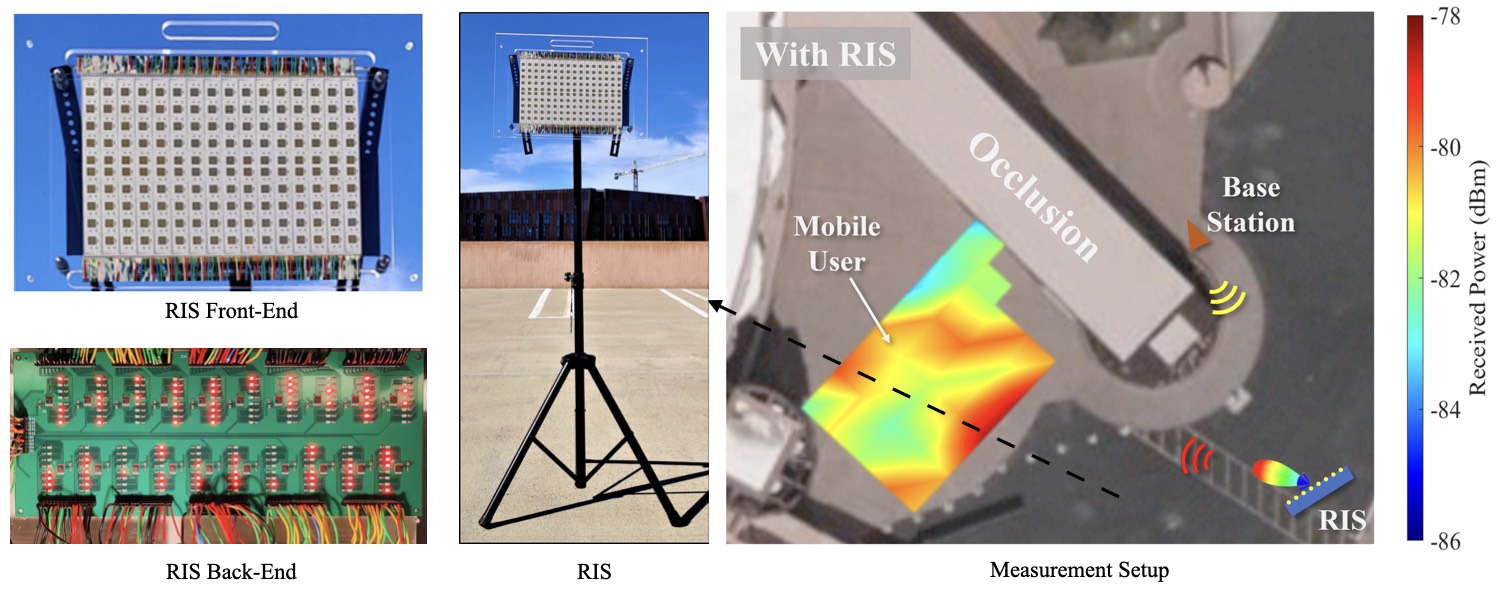Reconfigurable Intelligent Surfaces in Real-World Environment

The figure shows the developed 160-element RIS prototype at the sub-6GHz band and one of the measurement setups where a strong occlusion (blockage) exists between the BS and the grid of mobile users. The figure on the right illustrates the coverage gain (around 6dB on average over an area of 75m2) when the RIS is deployed
Key ideas
- Design and fabricate a reconfigurable intelligent surface at 5.8GHz
- Evaluate the performance of the developed RIS in realistic far-field settings
- The RIS adjusts its beam configuration using a pre-defined beam codebook
More information about this research direction
Paper: Georgios C. Trichopoulos, Panagiotis Theofanopoulos, Bharath Kashyap, Aditya Shekhawat, Anuj Modi, Tawfik Osman, Sanjay Kumar, Anand Sengar, Arkajyoti Chang, and Ahmed Alkhateeb, “Design and Evaluation of Reconfigurable Intelligent Surfaces in Real-World Environment,” in IEEE Open Journal of the Communications Society, vol. 3, pp. 462-474, 2022, doi: 10.1109/OJCOMS.2022.3158310.
Abstract: Reconfigurable intelligent surfaces (RISs) have promising coverage and data rate gains for wireless communication systems in 5G and beyond. Prior work has mainly focused on analyzing the performance of these surfaces using computer simulations or lab-level prototypes. To draw accurate insights about the actual performance of these systems, this paper develops an RIS proof-of-concept prototype and extensively evaluates its potential gains in the field and under realistic wireless communication settings. In particular, a 160-element reconfigurable surface, operating at a 5.8GHz band, is first designed, fabricated, and accurately measured in the anechoic chamber. This surface is then integrated into a wireless communication system and the beamforming gains, path-loss, and coverage improvements are evaluated in realistic outdoor communication scenarios. When both the transmitter and receiver employ directional antennas and with 5m and 10m distances between the transmitter-RIS and RIS-receiver, the developed RIS achieves 15-20dB gain in the signal-to-noise ratio (SNR) in a range of +- 60 degree beamforming angles. In terms of coverage, and considering a far-field experiment with a blockage between a base station and a grid of mobile users and with an average distance of 35m between base station (BS) and the user (through the RIS), the RIS provides an average SNR improvement of 6dB (max 8dB) within an area >75 m2. Thanks to the scalable RIS design, these SNR gains can be directly increased with larger RIS areas. For example, a 1,600-element RIS with the same design is expected to provide around 26dB SNR gain for a similar deployment. These results, among others, draw useful insights into the design and performance of RIS systems and provide an important proof for their potential gains in real-world far-field wireless communication environments.
@ARTICLE{Trichopoulos2022,
author={Trichopoulos, Georgios C. and Theofanopoulos, Panagiotis and Kashyap, Bharath and Shekhawat, Aditya and Modi, Anuj and Osman, Tawfik and Kumar, Sanjay and Sengar, Anand and Chang, Arkajyoti and Alkhateeb, Ahmed},
journal={IEEE Open Journal of the Communications Society},
title={Design and Evaluation of Reconfigurable Intelligent Surfaces in Real-World Environment},
year={2022},
volume={3},
number={},
pages={462-474},
doi={10.1109/OJCOMS.2022.3158310}}
Having questions or feedback?
Send an email to
